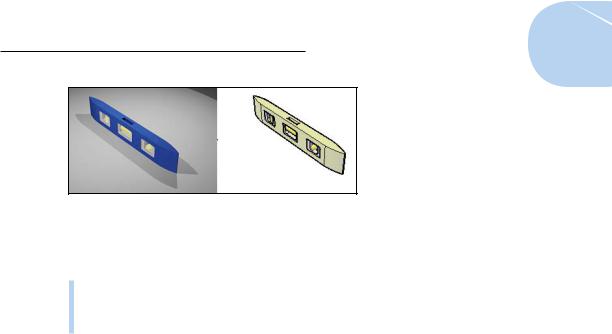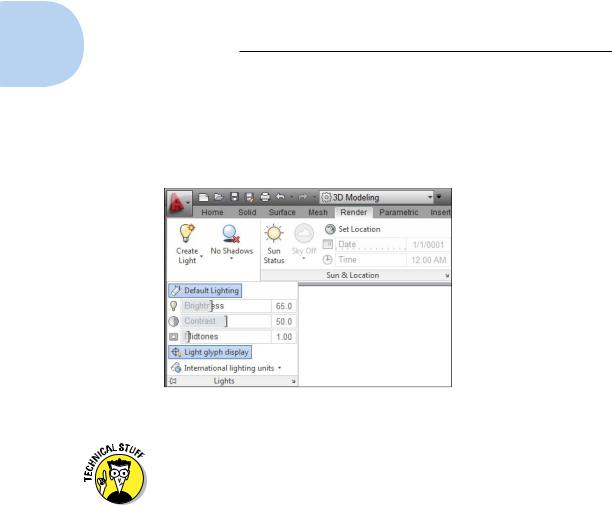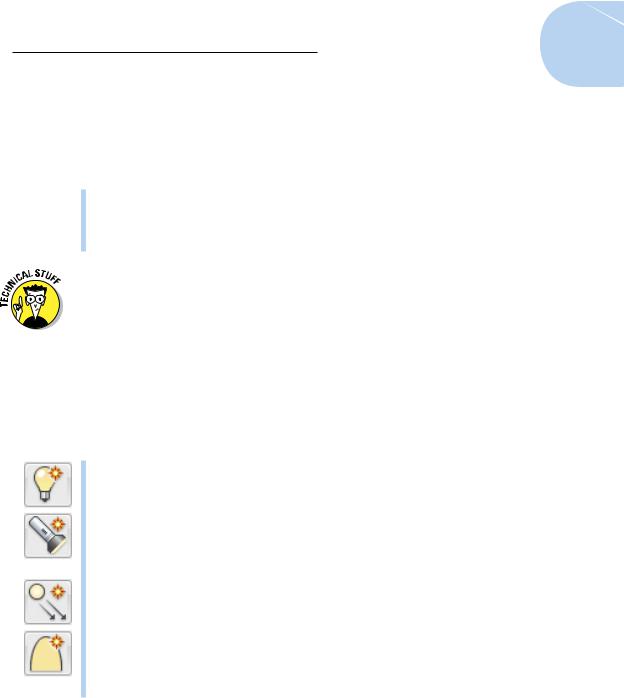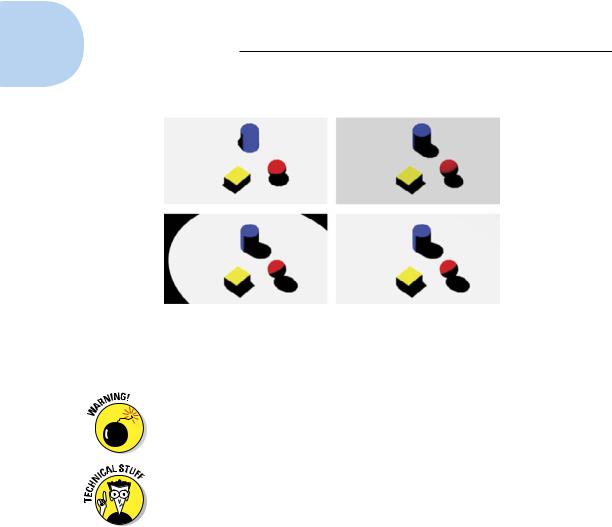
- •About the Authors
- •Dedication
- •Authors’ Acknowledgments
- •Table of Contents
- •Introduction
- •What’s Not (And What Is) in This Book
- •Mac attack!
- •Who Do We Think You Are?
- •How This Book Is Organized
- •Part I: AutoCAD 101
- •Part II: Let There Be Lines
- •Part III: If Drawings Could Talk
- •Part IV: Advancing with AutoCAD
- •Part V: On a 3D Spree
- •Part VI: The Part of Tens
- •But wait . . . there’s more!
- •Icons Used in This Book
- •A Few Conventions — Just in Case
- •Commanding from the keyboard
- •Tying things up with the Ribbon
- •Where to Go from Here
- •Why AutoCAD?
- •The Importance of Being DWG
- •Seeing the LT
- •Checking System Requirements
- •Suddenly, It’s 2013!
- •AutoCAD Does Windows (And Office)
- •And They’re Off: AutoCAD’s Opening Screens
- •Running with Ribbons
- •Getting with the Program
- •Looking for Mr. Status Bar
- •Let your fingers do the talking: The command window
- •The key(board) to AutoCAD success
- •Keeping tabs on palettes
- •Down the main stretch: The drawing area
- •Fun with F1
- •A Simple Setup
- •Drawing a (Base) Plate
- •Drawing rectangles on the right layers
- •Circling your plate
- •Nuts to you
- •Getting a Closer Look with Zoom and Pan
- •Modifying to Make It Merrier
- •Hip-hip-array!
- •Stretching out
- •Crossing your hatches
- •Following the Plot
- •A Setup Roadmap
- •Choosing your units
- •Weighing up your scales
- •Thinking annotatively
- •Thinking about paper
- •Defending your border
- •A Template for Success
- •Making the Most of Model Space
- •Setting your units
- •Making the drawing area snap-py (and grid-dy)
- •Setting linetype and dimension scales
- •Entering drawing properties
- •Making Templates Your Own
- •Setting Up a Layout in Paper Space
- •Will that be tabs or buttons?
- •View layouts Quick(View)ly
- •Creating a layout
- •Copying and changing layouts
- •Lost in paper space
- •Spaced out
- •A view(port) for drawing in
- •About Paper Space Layouts and Plotting
- •Managing Your Properties
- •Layer one on me!
- •Accumulating properties
- •Creating new layers
- •Manipulating layers
- •Using Named Objects
- •Using AutoCAD DesignCenter
- •Copying layers between drawings
- •Controlling Your Precision
- •Keyboard capers: Coordinate input
- •Understanding AutoCAD’s coordinate systems
- •Grab an object and make it snappy
- •Other Practical Precision Procedures
- •Introducing the AutoCAD Drawing Commands
- •The Straight and Narrow: Lines, Polylines, and Polygons
- •Toeing the line
- •Connecting the lines with polyline
- •Squaring off with rectangles
- •Choosing your sides with polygon
- •(Throwing) Curves
- •Going full circle
- •Arc-y-ology
- •Solar ellipses
- •Splines: The sketchy, sinuous curves
- •Donuts: The circles with a difference
- •Revision clouds on the horizon
- •Scoring Points
- •Commanding and Selecting
- •Command-first editing
- •Selection-first editing
- •Direct object manipulation
- •Choosing an editing style
- •Grab It
- •One-by-one selection
- •Selection boxes left and right
- •Perfecting Selecting
- •AutoCAD Groupies
- •Object Selection: Now You See It . . .
- •Get a Grip
- •About grips
- •A gripping example
- •Move it!
- •Copy, or a kinder, gentler Move
- •A warm-up stretch
- •Your AutoCAD Toolkit
- •The Big Three: Move, Copy, and Stretch
- •Base points and displacements
- •Move
- •Copy
- •Copy between drawings
- •Stretch
- •More Manipulations
- •Mirror
- •Rotate
- •Scale
- •Array
- •Offset
- •Slicing, Dicing, and Splicing
- •Trim and Extend
- •Break
- •Fillet and Chamfer and Blend
- •Join
- •When Editing Goes Bad
- •Zoom and Pan with Glass and Hand
- •The wheel deal
- •Navigating your drawing
- •Controlling your cube
- •Time to zoom
- •A View by Any Other Name . . .
- •Looking Around in Layout Land
- •Degenerating and Regenerating
- •Getting Ready to Write
- •Simply stylish text
- •Taking your text to new heights
- •One line or two?
- •Your text will be justified
- •Using the Same Old Line
- •Turning On Your Annotative Objects
- •Saying More in Multiline Text
- •Making it with Mtext
- •It slices; it dices . . .
- •Doing a number on your Mtext lists
- •Line up in columns — now!
- •Modifying Mtext
- •Gather Round the Tables
- •Tables have style, too
- •Creating and editing tables
- •Take Me to Your Leader
- •Electing a leader
- •Multi options for multileaders
- •How Do You Measure Up?
- •A Field Guide to Dimensions
- •The lazy drafter jumps over to the quick dimension commands
- •Dimension associativity
- •Where, oh where, do my dimensions go?
- •The Latest Styles in Dimensioning
- •Creating and managing dimension styles
- •Let’s get stylish!
- •Adjusting style settings
- •Size Matters
- •Details at other scales
- •Editing Dimensions
- •Editing dimension geometry
- •Editing dimension text
- •Controlling and editing dimension associativity
- •Batten Down the Hatches!
- •Don’t Count Your Hatches. . .
- •Size Matters!
- •We can do this the hard way. . .
- •. . . or we can do this the easy way
- •Annotative versus non-annotative
- •Pushing the Boundary (Of) Hatch
- •Your hatching has no style!
- •Hatch from scratch
- •Editing Hatch Objects
- •You Say Printing, We Say Plotting
- •The Plot Quickens
- •Plotting success in 16 steps
- •Get with the system
- •Configure it out
- •Preview one, two
- •Instead of fit, scale it
- •Plotting the Layout of the Land
- •Plotting Lineweights and Colors
- •Plotting with style
- •Plotting through thick and thin
- •Plotting in color
- •It’s a (Page) Setup!
- •Continuing the Plot Dialog
- •The Plot Sickens
- •Rocking with Blocks
- •Creating Block Definitions
- •Inserting Blocks
- •Attributes: Fill-in-the-Blank Blocks
- •Creating attribute definitions
- •Defining blocks that contain attribute definitions
- •Inserting blocks that contain attribute definitions
- •Edit attribute values
- •Extracting data
- •Exploding Blocks
- •Purging Unused Block Definitions
- •Arraying Associatively
- •Comparing the old and new ARRAY commands
- •Hip, hip, array!
- •Associatively editing
- •Going External
- •Becoming attached to your xrefs
- •Layer-palooza
- •Creating and editing an external reference file
- •Forging an xref path
- •Managing xrefs
- •Blocks, Xrefs, and Drawing Organization
- •Mastering the Raster
- •Attaching a raster image
- •Maintaining your image
- •Theme and Variations: Dynamic Blocks
- •Lights! Parameters!! Actions!!!
- •Manipulating dynamic blocks
- •Maintaining Design Intent
- •Defining terms
- •Forget about drawing with precision!
- •Constrain yourself
- •Understanding Geometric Constraints
- •Applying a little more constraint
- •AutoConstrain yourself!
- •Understanding Dimensional Constraints
- •Practice a little constraint
- •Making your drawing even smarter
- •Using the Parameters Manager
- •Dimensions or constraints — have it both ways!
- •The Internet and AutoCAD: An Overview
- •You send me
- •Send it with eTransmit
- •Rapid eTransmit
- •Bad reception?
- •Help from the Reference Manager
- •Design Web Format — Not Just for the Web
- •All about DWF and DWFx
- •Autodesk Design Review 2013
- •The Drawing Protection Racket
- •Autodesk Weather Forecast: Increasing Cloud
- •Working Solidly in the Cloud
- •Free AutoCAD!
- •Going once, going twice, going 123D
- •Your head planted firmly in the cloud
- •The pros
- •The cons
- •Cloudy with a shower of DWGs
- •AutoCAD 2013 cloud connectivity
- •Tomorrow’s Forecast
- •Understanding 3D Digital Models
- •Tools of the Trade
- •Warp speed ahead
- •Entering the third dimension
- •Untying the Ribbon and opening some palettes
- •Modeling from Above
- •Using 3D coordinate input
- •Using point filters
- •Object snaps and object snap tracking
- •Changing Planes
- •Displaying the UCS icon
- •Adjusting the UCS
- •Navigating the 3D Waters
- •Orbit à go-go
- •Taking a spin around the cube
- •Grabbing the SteeringWheels
- •Visualizing 3D Objects
- •Getting Your 3D Bearings
- •Creating a better 3D template
- •Seeing the world from new viewpoints
- •From Drawing to Modeling in 3D
- •Drawing basic 3D objects
- •Gaining a solid foundation
- •Drawing solid primitives
- •Adding the Third Dimension to 2D Objects
- •Creating 3D objects from 2D drawings
- •Modifying 3D Objects
- •Selecting subobjects
- •Working with gizmos
- •More 3D variants of 2D commands
- •Editing solids
- •Get the 2D Out of Here!
- •A different point of view
- •But wait! There’s more!
- •But wait! There’s less!
- •Do You See What I See?
- •Visualizing the Digital World
- •Adding Lighting
- •Default lighting
- •User-defined lights
- •Sunlight
- •Creating and Applying Materials
- •Defining a Background
- •Rendering a 3D Model
- •Autodesk Feedback Community
- •Autodesk Discussion Groups
- •Autodesk’s Own Bloggers
- •Autodesk University
- •The Autodesk Channel on YouTube
- •The World Wide (CAD) Web
- •Your Local ATC
- •Your Local User Group
- •AUGI
- •Books
- •Price
- •3D Abilities
- •Customization Options
- •Network Licensing
- •Express Tools
- •Parametrics
- •Standards Checking
- •Data Extraction
- •MLINE versus DLINE
- •Profiles
- •Reference Manager
- •And The Good News Is . . .
- •APERTURE
- •DIMASSOC
- •MENUBAR
- •MIRRTEXT
- •OSNAPZ
- •PICKBOX
- •REMEMBERFOLDERS
- •ROLLOVERTIPS
- •TOOLTIPS
- •VISRETAIN
- •And the Bonus Round
- •Index

Chapter 23: On a Render Bender 525
Figure 23-6: Rendering compared with Conceptual visual style.
Before rendering a 3D model, you need to do the following:
Add lighting to highlight features and define shadows.
Apply materials to 3D objects by face, object, or layer.
Set up a background for your 3D model to be rendered against.
All the above-mentioned items help to bring realism to a 3D model. This chapter focuses on each of these tasks before covering the steps to create a rendering.
Adding Lighting
One of the key ingredients in the soup that makes a rendering look good is lighting. Lighting helps give a model depth through the use of highlights and shadows. Just as in the real world, objects that are closest to the light source appear the brightest and those the farthest away appear the darkest.
The two types of lighting in AutoCAD are default and user-defined. Default lighting, as its name suggests, is on and available in every drawing, and it’s what gives some basic form to your 3D model when you click the Render button before you add lighting of your own. All types of user-defined lights can cast shadows. Most tools that you use to create and edit lights are located on the Lights and Sun & Location panels of the Render tab.
Default lighting
Over the past few years, AutoCAD’s default lighting has improved in quality. Prior to AutoCAD 2007, default lighting consisted of a single, distant light source, always directed toward the target of your current view from behind your back. AutoCAD 2007 added a second default light to help increase the lighting level, and to balance the lighting in a viewport.
www.it-ebooks.info

526 Part V: On a 3D Spree
Default lighting can’t cast shadows, so we don’t recommend using it for final renderings. It does work pretty well for quick conceptual renderings, however. You can control the brightness, contrast, and midtones levels for default lighting with the slider controls on the slideout of the Lights panel on the Render tab of Ribbon (see Figure 23-7).
Figure 23-7: AutoCAD to lights, extra brightness is a go.
Use the DEFAULTLIGHTING system variable to enable and disable the use of default lighting in the current viewport. Set DEFAULTLIGHTING to 0 when you want user-defined lighting to render your 3D model. If you’re using default lighting, the DEFAULTLIGHTINGTYPE system variable controls whether one or two default distant lights are used. When set to 0, one default light is used; when set to 1, two default lights are used.
User-defined lights
Default lights are fine for quick renderings, but they don’t bring your renderings to life in the way that user-defined lights can. User-defined lights are lights that you create — with one exception — and modify in your 3D model. The only user-definable light type that you can enable and modify, but can’t create, is the sunlight system.
The first time that a user-defined light is placed in a drawing, the Lighting – Viewport Lighting Mode alert box is displayed, advising you that you need to turn off default lighting in order to see light from user-defined sources.
Click Turn Off the Default Lighting to disable default lighting. (To turn default lighting back on, open the Lights panel slideout on the Render tab and click
www.it-ebooks.info

Chapter 23: On a Render Bender 527
Default Lighting.) You should always disable default lighting when using userdefined lights; otherwise you can end up overlighting your model, making it look unnatural.
The two types of user-defined lights that you can create are generic and photometric:
Generic lights: Provide advanced control over how they emit light and are much more complex than photometric lights.
Photometric lights: More convenient to use as they are defined to represent how lights work in the physical world.
The LIGHTINGUNITS system variable controls whether user-defined lights in your drawing are represented as generic or photometric lights. When LIGHTINGUNITS is set to 0, generic lights are used. When LIGHTINGUNITS is
set to 1 or 2, photometric lights are used; 1 indicates American lighting units, and 2 indicates International lighting units. Lights don’t have to be removed and added to switch between generic and photometric lights; you just need to switch the system variable.
To add a user-defined light to your drawing, click the lower half of the Create Light split button on the Lights panel of the Render tab. You can choose from four distinct types of lights on the flyout (for the differences between the light types, see Figure 23-8):
Point light: Emits light uniformly in all directions, but the emitted light falls off the farther it gets from the source. A point light is similar to a candle or a lantern.
Spotlight: Emits light in a specific direction. As light travels farther from the source, it spreads out in the shape of a cone. You can define the hotspot — the brightest part of the emitted light — and the fall-off of the light.
Distant light: Emits light along a specified vector and doesn’t decay or fall off like other user-defined lights do. A distant light is similar to the sun.
Weblight: A cross between a point light and a spotlight. Weblights are available only when using photometric lights, and the way they emit light is determined by an IES file. IES files are provided by lighting companies for use in products like AutoCAD to mimic the lights that they manufacture.
www.it-ebooks.info

528 Part V: On a 3D Spree
Point light |
Spotlight |
Distant light Weblight
Figure 23-8: Lighting primitives with the four types of user-defined lights.
AutoCAD and we both strongly advise against using distant lights when using photometric lighting. If you decide to ignore this warning, make sure to turn down the intensity factor of the distant light to avoid washing out your rendering.
Point lights, spotlights, and weblights can be selected and edited directly in a drawing because a glyph is displayed to show where the light is located. Distant lights do not have an associated glyph. (A glyph is a nonprinting object displayed in a drawing that enables you to select an object that is not part of the actual model.)
Shadows . . . or no shadows?
AutoCAD allows you to define lights that can’t generate shadows. This might seem illogical because shadows are cast when light is obscured by an object. This is important because you may want to fill an area with light but not have it affect the way shadows are cast.
To control the shadows a light can generate, select a light, right-click, and then choose Properties to open the Properties palette. The Shadows option in the General category enables or disables shadow creation from
the selected light. The Rendered Shadow Details category gives you a large degree of creative control over shadow appearance. For more information on putting your objects in the shade, open the online help and search on Render
3D Objects for Realism.
www.it-ebooks.info
